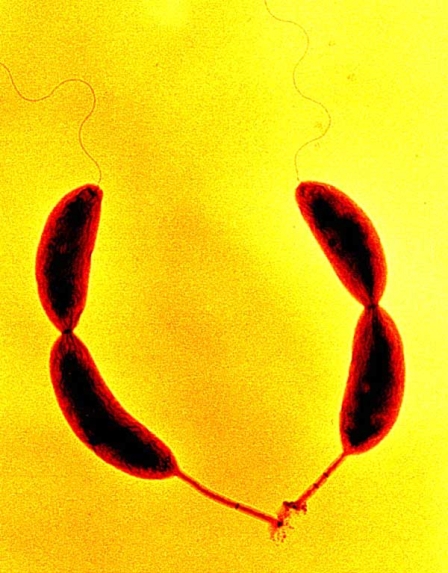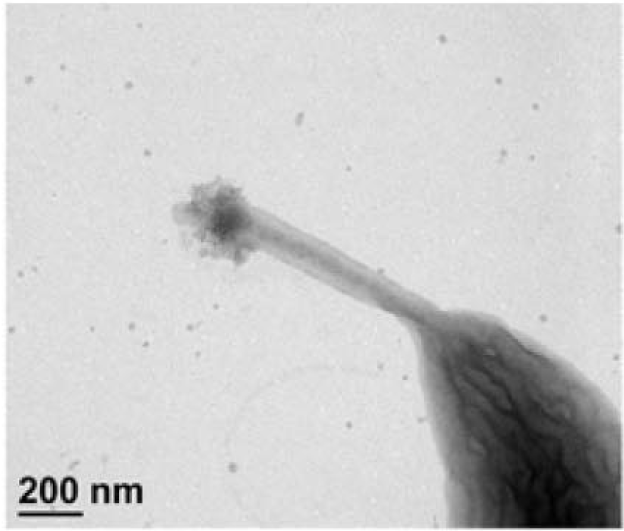Team:ULB-Brussels/Project/Introduction
From 2009.igem.org
| Line 31: | Line 31: | ||
Our aim is to find a way of mass-producing the glue. For this purpose, we planned to transfer the ''C. crescentus'' holdfast polysaccharide biosynthesis pathway to ''Escherichia coli''. | Our aim is to find a way of mass-producing the glue. For this purpose, we planned to transfer the ''C. crescentus'' holdfast polysaccharide biosynthesis pathway to ''Escherichia coli''. | ||
| - | As ''Escherichia coli'' possesses similar genes | + | As ''Escherichia coli'' possesses similar genes [https://2009.igem.org/Team:ULB-Brussels/Project/Appendix Appendix] involved in the production and the export of the holdfast in ''C. crescentus'', we only inserted the hfsG and hfsH genes in an ''E. Coli'' strain : GluColi was born. |
The problem of stickiness to the material of the container used to produce the glue was not investigated. In fact, we thought it was more relevant to synthesize the glue whenever and wherever it is required, instead of focusing on the extraction of the adhesive. For this purpose, we designed a theoretical circuit using chemotaxis and quorum sensing. | The problem of stickiness to the material of the container used to produce the glue was not investigated. In fact, we thought it was more relevant to synthesize the glue whenever and wherever it is required, instead of focusing on the extraction of the adhesive. For this purpose, we designed a theoretical circuit using chemotaxis and quorum sensing. | ||
GluColi started producing an adhesive material and we begun to characterize the glue in the "Physical and chemical properties of our glue" section. The mathematical modeling will also be considered. | GluColi started producing an adhesive material and we begun to characterize the glue in the "Physical and chemical properties of our glue" section. The mathematical modeling will also be considered. | ||
Revision as of 02:04, 22 October 2009
Introduction
Caulobacter crescentus is a gram-negative bacterium studied for the properties of its cell cycle (2), (7).This bacterium is widely spread in aquatic environments and exists either as a motile cell or as a sessile cell (see figure below). In the sessile stage, C. crescentus sticks to surfaces by synthesizing adhesive at the stalk, a polar organelle shown in figure below). At the tip of this appendage, a complex holdfast structure is assembled.
This material is an elastic, gel-like adhesive substance composed of both protein and polysaccharide. The N-acetylglucosamine polymer has been identified as the main polysaccharide component (8). This holdfast shows unprecedented adhesive properties: the adhesive can adhere with a strength up to 68 N/mm2. In comparison, commercial superglue can withstand a force of 18-30 N/mm2 (9),(10),(11).
Since this adhesive adheres to wet surfaces, many industrial applications are foreseen. The glue has already been isolated but the challenge is to produce large amounts of glue without it sticking to the material where it is produced.
A model of holdfast biosynthesis, export and attachment in C. crescentus has already been characterized, see Figure below, (11).
The hfsE hfsF hfsG hfsH genes are organized in operon and their products are required for the minimum repeat unit holdfast synthesis while the polymerization of the repeat unit of the holdfast substance needs the expression of hfsC and hfsI genes.
The products of the 3 adjacent hfsD hfsA and hfsB genes are involved in the holdfast export. The anchoring of the holdfast polysaccharide is carried out by the hfa gene products. (12)

Our aim is to find a way of mass-producing the glue. For this purpose, we planned to transfer the C. crescentus holdfast polysaccharide biosynthesis pathway to Escherichia coli.
As Escherichia coli possesses similar genes Appendix involved in the production and the export of the holdfast in C. crescentus, we only inserted the hfsG and hfsH genes in an E. Coli strain : GluColi was born.
The problem of stickiness to the material of the container used to produce the glue was not investigated. In fact, we thought it was more relevant to synthesize the glue whenever and wherever it is required, instead of focusing on the extraction of the adhesive. For this purpose, we designed a theoretical circuit using chemotaxis and quorum sensing.
GluColi started producing an adhesive material and we begun to characterize the glue in the "Physical and chemical properties of our glue" section. The mathematical modeling will also be considered.
 "
"


